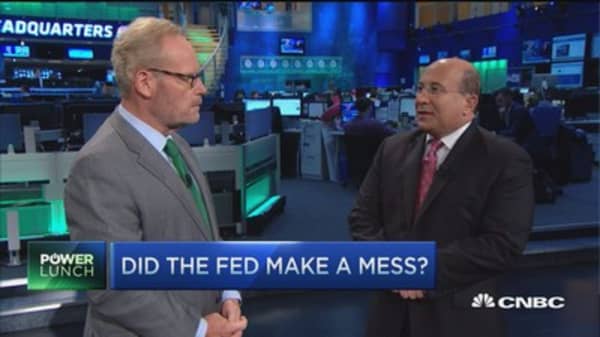The Federal Reserve is creating a negative-feedback loop with its mixed messages on interest rates — and it's messing with the markets.
In explaining why the Fed opted to hold rates steady, Fed Chair Janet Yellen said that policy makers remain concerned about slowing economic growth — especially in China — and the impact on global markets and inflation.
But then, she added that the Fed could still raise rates in before the year was out — as early as October.
What?
If slowing global growth and market turbulence was a reason to pause, how likely was it, then, that all of that would be resolved by October?
Since Chair Yellen spoke, a number of Fed officials have spoken, reiterating that a rate hike in 2015 remains likely. This is cognitive dissonance at its worst. Investors are now simultaneously worried about incompatible outcomes.
If growth is weak, and inflation continues to fall, the Fed should NOT, and would NOT, raise rates. If this global problem is truly transitory (a word most Fed officials need to look up in the dictionary), then a rate hike should have already occurred.
This is a problem of the Fed's own making. By insisting that interest rate normalization is imminent, the Fed is creating the very problem it is combatting by delaying that very same process.
From my vantage point, the Fed more clearly needs to define what it takes to meet its dual mandate — inflation and employment.
Clearly, the Fed has reached many of its goals on the employment front, although wage inflation is not accelerating to the point where a rate hike would be justified to cool an overheating economy.
Low inflation, while "transitory," has persisted for nearly six years and is being pushed even lower by the huge drop in oil prices; the crash in other commodities; slowing growth in China and Japan and Asian emerging markets; recessions in Russia and Brazil and uneven growth in Europe.
If the world is not normal, why normalize policy at all? The world affects the U.S. As we have seen in innumerable instances in the past, global instability has altered the course of domestic monetary policy for decades.
Factoring that in, does not mean that the Fed has a "third mandate" as some Fed bashers claim. It simply means that the Fed has an obligation to consider how all variables affect its mandate.
With an economy only "half-normal," the normalization of interest rates can wait. But if the Fed continues to convey confusing messages about the timing of normalization, in an abnormal world, it will only serve to exacerbate the very trends it is hoping will abate.
Right now, those trends do not seem likely to change before the end of the year. Rate hike in March 2016, anyone?
Commentary by Ron Insana, a CNBC and MSNBC contributor and the author of four books on Wall Street. Follow him on Twitter @rinsana.







